Mayukh Nath
Effect of nearby Metals on Electro-Quasistatic Human Body Communication
Oct 06, 2025Abstract:In recent decades Human Body Communication has emerged as a promising alternative to traditional radio wave communication, utilizing the body's conductive properties for low-power connectivity among wearables. This method harnesses the human body as an energy-efficient channel for data transmission within the electro-quasistatic frequency range, enabling advancements in human-machine interaction. While prior work has noted the role of parasitic return paths in such capacitively coupled systems, the influence of surrounding metallic objects on these paths, which are critical for EQS wireless signaling, has not been fully explored. This paper fills that gap with a structured study of how various conducting objects, from non-grounded (floating) metals and grounded metals to enclosed metallic environments such as elevators and cars, affect the body-communication channel. We present a theoretical framework supported by finite element method simulations and experiments with wearable devices. Results show that metallic objects within 20 cm of devices can reduce transmission loss by about 10 dB. When a device ground connects to a grounded metallic object, channel gain can increase by at least 20 dB. Contact area during touch-based interactions with grounded metals produces contact-impedance dependent high-pass channel characteristics. Proximity to metallic objects introduces variability within a critical distance, with grounded metals producing a larger overall effect than floating metals. These findings improve understanding of body-centric communication links and inform design for healthcare, consumer electronics, defense, and industrial applications.
Body-Resonance Human Body Communication
Nov 16, 2024Abstract:Seamless interaction between Humans and AI-empowered battery-operated miniaturized electronic devices, exponentially transforming the wearable technology industry while forming an anthropomorphic artificial nervous system for distributed computing around the human body, demands high-speed low-power connectivity. If interconnected via radio frequency (RF) based wireless communication techniques, that being radiative, incur substantial absorption losses from the body during non-line-of-sight scenarios and consume higher power (more than 10s of mW). Although as a promising alternative with its non-radiative nature that resulted in 100X improvement in energy efficiency (sub-10 pJ/bit) and better signal confinement, Electro-Quasistatic Human Body Communication (EQS HBC) incurs moderate path loss (60-70 dB), limited data rate (less than 20 Mbps), making it less suitable for applications demanding fast connectivity like HD audio-video streaming, AR-VR-based products, distributed computing with wearable AI devices. Hence, to meet the requirement of energy-efficient connectivity at 100s of Mbps between wearables, we propose Body-Resonance (BR) HBC, which operates in the near-intermediate field and utilizes the transmission-line-like behavior of the body channel to offer 30X improvement in channel capacity. Our work sheds new light on the wireless communication system for wearables with potential to increase the channel gain by 20 dB with a 10X improvement in bandwidth compared to the EQS HBC for communication over on-body channels (whole-body coverage area). Experimentally demonstrating BR HBC, we presented low-loss (40-50 dB) and wide-band (hundreds of MHz) body channels that are 10X less leaky than radiative wireless communication, hence, can revolutionize the design of wireless communication system for several applications with wearables from healthcare, defense, to consumer electronics.
Efficient Communication and Powering for Smart Contact Lens with Resonant Magneto-Quasistatic Coupling
Jun 12, 2024



Abstract:A two-coil wearable system is proposed for wireless communication and powering between a transmitter coil in a necklace and a receiver coil in a smart contact lens, where the necklace is invisible in contrast to coils embedded in wearables like spectacles or headbands. Magneto-quasistatic(MQS) field coupling facilitates communication between the transmitter in the necklace and the contact lens receiver, enabling AR/VR and health monitoring. As long as the receiver coil remains within the magnetic field generated by the transmitter, continuous communication is sustained through MQS field coupling despite the misalignments present. Resonant frequency tuning enhances system efficiency. The system's performance was tested for coil misalignments, showing a maximum path loss variation within $10 dB$ across scenarios, indicating robustness. Finite Element Method(FEM) analysis has been used to study the system for efficient wireless data transfer and powering. A communication channel capacity is $4.5 Mbps$ over a $1 MHz$ bandwidth. Simulations show negligible path loss differences with or without human tissues, as magnetic coupling remains unaffected at MQS frequencies below $30 MHz$ due to similar magnetic permeability of tissues and air. Therefore, the possibility of efficient communication and powering of smart contact lenses through a necklace is shown for the first time using resonant MQS coupling at an axial distance of $15cm$ and lateral distance of over $9cm$ to enable AR/VR and health monitoring on the contact lens.
Bi-Phasic Quasistatic Brain Communication for Fully Untethered Connected Brain Implants
May 18, 2022Abstract:Wireless communication using electro-magnetic (EM) fields acts as the backbone for information exchange among wearable devices around the human body. However, for Implanted devices, EM fields incur high amount of absorption in the tissue, while alternative modes of transmission including ultrasound, optical and magneto-electric methods result in large amount of transduction losses due to conversion of one form of energy to another, thereby increasing the overall end-to-end energy loss. To solve the challenge of powering and communication in a brain implant with low end-end channel loss, we present Bi-Phasic Quasistatic Brain Communication (BP-QBC), achieving < 60dB worst-case end-to-end channel loss at a channel length of 55mm, by avoiding the transduction losses during field-modality conversion. BP-QBC utilizes dipole coupling based signal transmission within the brain tissue using differential excitation in the transmitter and differential signal pick-up at the receiver, and offers 41X lower power w.r.t. traditional Galvanic Human Body Communication at a carrier frequency of 1MHz, by blocking any DC current paths through the brain tissue. Since the electrical signal transfer through the human tissue is electro-quasistatic up to several 10's of MHz range, BP-QBC allows a scalable (bps-10Mbps) duty-cycled uplink from the implant to an external wearable. The power consumption in the BP-QBC TX is only 0.52uW at 1Mbps (with 1% duty cycling), which is within the range of harvested body-coupled power in the downlink from an external wearable to the brain implant. Furthermore, BP-QBC eliminates the need for sub-cranial repeaters, as it utilizes quasi-static electrical signals, thereby avoiding any transduction losses. Such low end-to-end channel loss with high data rates would find applications in neuroscience, brain-machine interfaces, electroceuticals and connected healthcare.
Channel Modeling for Physically Secure Electro-Quasistatic In-Body to Out-of-Body Communication with Galvanic Tx and Multimodal Rx
Apr 27, 2022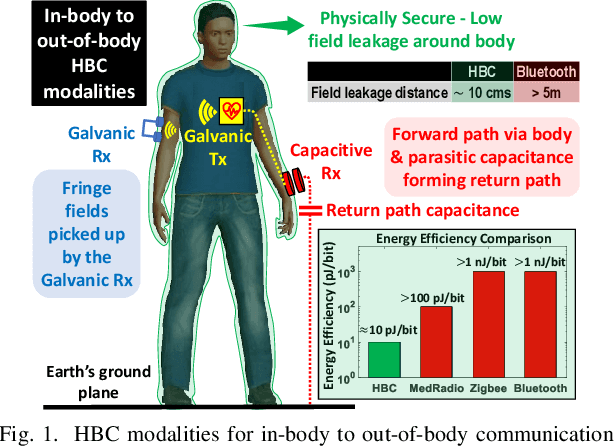
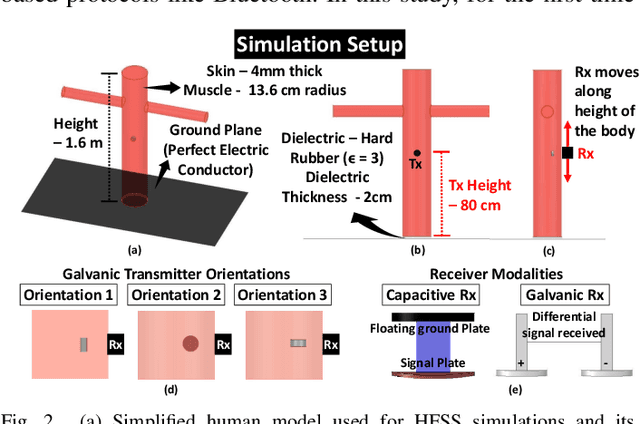

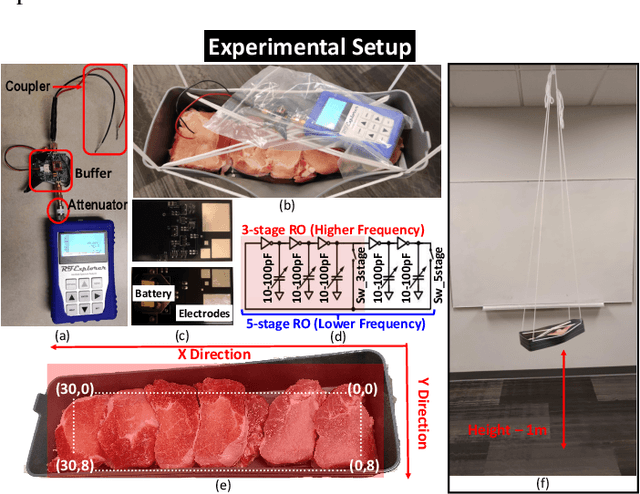
Abstract:Increasing number of devices being used in and around the human body has resulted in the exploration of the human body as a communication medium. In this paper, we design a channel model for implantable devices communicating outside the body using physically secure Electro-Quasistatic Human Body Communication. A galvanic receiver shows 5dB lower path loss than capacitive receiver when placed close to transmitter whereas a capacitive receiver has around 15dB lower path loss for larger separation between the transmitter and receiver. Finite Element Method (FEM) based simulations are used to analyze the communication channel for different receiver topologies and experimental data is used to validate the simulation results.
A Quantitative Analysis of Physical Security and Path Loss With Frequency for IBOB Channel
Apr 27, 2022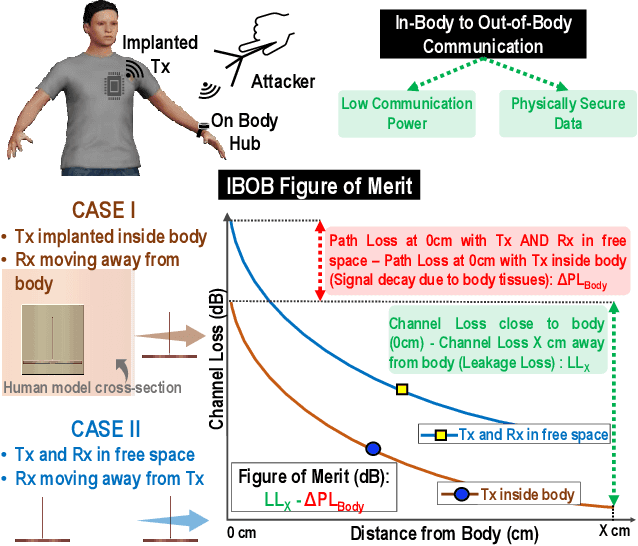
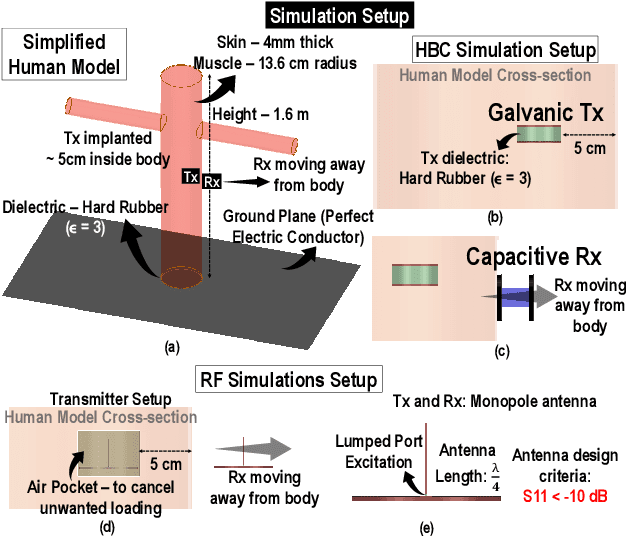

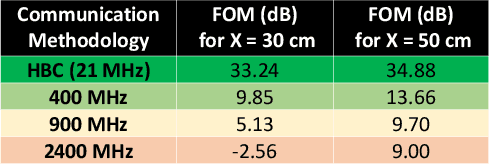
Abstract:Security vulnerabilities demonstrated in implantable medical devices have opened the door for research into physically secure and low power communication methodologies. In this study, we perform a comparative analysis of commonly used ISM frequency bands and human body communication (HBC) for data transfer from in-body to out-of-body (IBOB). We develop a figure of merit (FoM) that comprises of the critical parameters to quantitatively compare the communication methodologies. We perform finite-element method (FEM)-based simulations and experiments to validate the FoM developed.
 Add to Chrome
Add to Chrome Add to Firefox
Add to Firefox Add to Edge
Add to Edge